Analyzing traffic accidents
Data: Accident data in NYC
Techniques: Exploratory analysis
Analyzing publicly available data on traffic accidents in NYC from 2009-2016 (work in progress).
%matplotlib inline
import numpy as np
import pandas as pd
from collections import defaultdict
import csv
import seaborn as sns
import matplotlib.pyplot as plt
import plotly.plotly as py
import plotly.tools as tls
from ggplot import *
def make_int(i):
"""
Make strings into integers
"""
if i == '':
return None
else:
return int(i)
def group_data(data, key_name):
"""
Building a dict of lists
"""
grouped_data = defaultdict(list)
for data_point in data:
key = data_point[key_name]
grouped_data[key].append(data_point)
return grouped_data
def sum_grouped_items(grouped_data, field_name):
summed_data = {}
for key, data_points in grouped_data.items():
total = 0
for data_point in data_points:
total += data_point[field_name]
summed_data[key] = total
return summed_data
def cleanup(dic):
"""
Make string years into integers and sort (by year)
"""
year, total = zip(*(sorted(dic.items())))
return list(map(int,year)), total
def describe_data(data):
print('Mean:', np.mean(data))
print('Std:', np.std(data))
print('Min:', np.min(data))
print('Max:', np.max(data))
def percent_of_total(specific,total):
"""Get percent of total"""
return (specific/total)*100
with open('fatality_monthly.csv') as f:
reader = csv.DictReader(f)
records = list(reader)
for record in records:
record['Fatalities'] = make_int(record['Fatalities'])
record['PedFatalit'] = make_int(record['PedFatalit'])
record['BikeFatali'] = make_int(record['BikeFatali'])
record['MVOFatalit'] = make_int(record['MVOFatalit'])
# Group by year
accidents_by_year = group_data(records, 'YR')
# Deleting 2016 because we don't have complete records.
del accidents_by_year['2016']
Fatalities by year
total_by_year = sum_grouped_items(accidents_by_year, 'Fatalities')
total_bike_by_year = sum_grouped_items(accidents_by_year, 'BikeFatali')
total_ped_by_year = sum_grouped_items(accidents_by_year, 'PedFatalit')
total_mvo_by_year = sum_grouped_items(accidents_by_year, 'MVOFatalit')
Total fatalities by year
total_fatalities = total_by_year.values()
describe_data(list(total_fatalities))
Mean: 220.428571429
Std: 19.1971511492
Min: 191
Max: 255
The mean number of fatalities from 2009 - 2015 was about 220.
total_by_year_list = cleanup(total_by_year)
plt.bar(range(len(total_by_year_list[0])),total_by_year_list[1],align='center')
plt.title('Total fatalities by year')
plt.ylabel('fatalities')
plt.xlabel('year')
plt.xticks(range(len(total_by_year_list[0])),total_by_year_list[0])
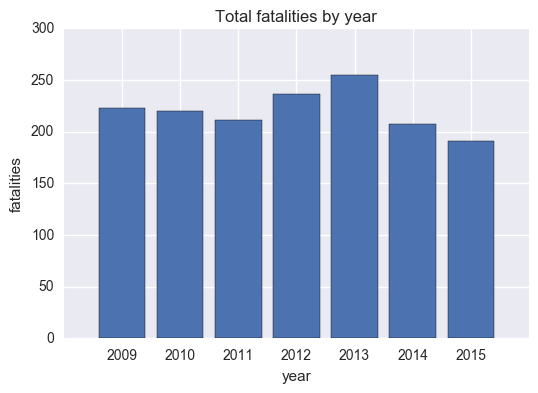
Bike fatalities by year
total_bike_by_year_list = cleanup(total_bike_by_year)
plt.bar(range(len(total_bike_by_year_list[0])),total_bike_by_year_list[1],align='center')
plt.xticks(range(len(total_bike_by_year_list[0])),total_bike_by_year_list[0])
plt.title('Total bike fatalities by year')
plt.xlabel('year')
plt.ylabel('bike fatalities')
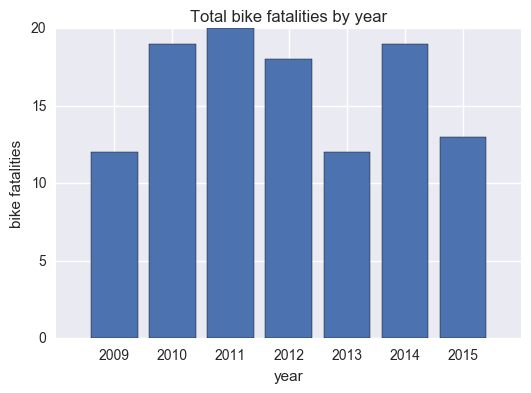
Pedestrian fatalities by year
total_ped_by_year_list = cleanup(total_ped_by_year)
plt.bar(range(len(total_ped_by_year_list[0])),total_ped_by_year_list[1],align='center')
plt.xticks(range(len(total_ped_by_year_list[0])),total_ped_by_year_list[0])
plt.title('Total pedestrianfatalities by year')
plt.xlabel('year')
plt.ylabel('pedestrian fatalities')
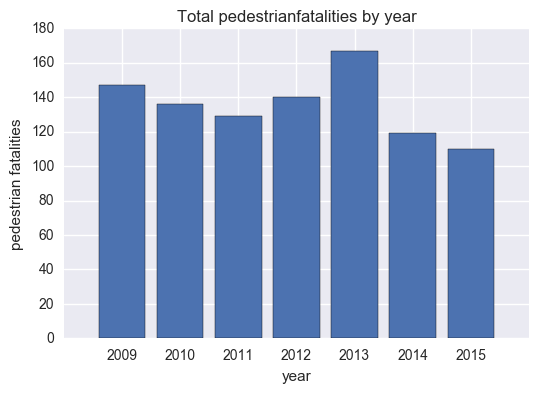
Motor vehicle fatalities by year
total_mvo_by_year_list = cleanup(total_mvo_by_year)
plt.bar(range(len(total_mvo_by_year_list[0])),total_mvo_by_year_list[1],align='center')
plt.xticks(range(len(total_mvo_by_year_list[0])),total_mvo_by_year_list[0])
plt.title('Total pedestrian fatalities by year')
plt.xlabel('year')
plt.ylabel('pedestrian fatalities')
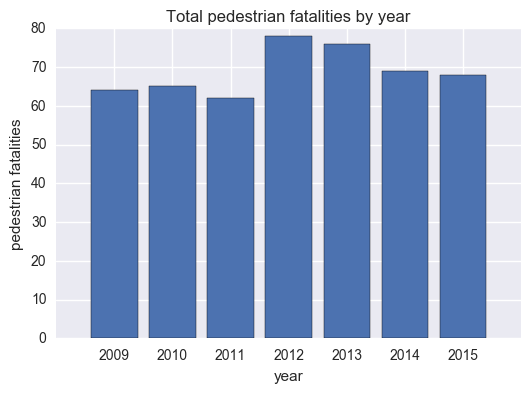
Fatalities by type as a percentage of total
total_year_s = pd.Series(total_by_year)
total_bike_year_s = pd.Series(total_bike_by_year)
total_ped_year_s = pd.Series(total_ped_by_year)
total_mvo_year_s = pd.Series(total_mvo_by_year)
bike_percent = percent_of_total(total_bike_year_s, total_year_s)
ped_percent = percent_of_total(total_ped_year_s, total_year_s)
mvo_percent = percent_of_total(total_mvo_year_s, total_year_s)
print(bike)
print(ped)
print(mvo)
2009 5.381166
2010 8.636364
2011 9.478673
2012 7.627119
2013 4.705882
2014 9.178744
2015 6.806283
dtype: float64
2009 28.699552
2010 29.545455
2011 29.383886
2012 33.050847
2013 29.803922
2014 33.333333
2015 35.602094
dtype: float64
2009 28.699552
2010 29.545455
2011 29.383886
2012 33.050847
2013 29.803922
2014 33.333333
2015 35.602094
dtype: float64
# Check that the percentanges add to 100
bike_pct = pd.Series(bike_percent)
ped_pct = pd.Series(ped_percent)
mvo_pct = pd.Series(mvo_percent)
bike_pct + ped_pct + mvo_pct
2009 100.0
2010 100.0
2011 100.0
2012 100.0
2013 100.0
2014 100.0
2015 100.0
dtype: float64
Fatalities by type in one plot
multiple_bars=plt.figure()
x=[2009,2010,2011,2012,2013,2014,2015]
ind=np.arange(len(x))
bike=bike_percent
ped=ped_percent
mvo=mvo_percent
ax.set_title('Percentage of fatalities by type')
ax=plt.subplot(111)
ax.bar(ind-.2, ped, width=.2, color='r', align='center', label='ped')
ax.bar(ind, mvo, width=.2, color='g', align='center', label='MV')
ax.bar(ind+.2, bike, width=.2, color='b', align='center', label='bike')
ax.set_xticks(ind)
ax.set_xticklabels(x)
ax.set_ylabel('Percentage of total')
ax.set_xlabel('Year')
ax.legend(loc='best')
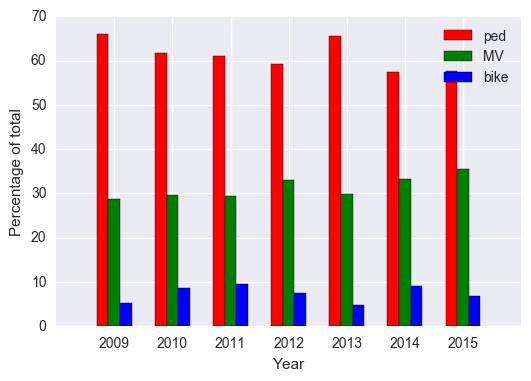
Mapping fatalities
fatalities = pd.read_csv('fatality_monthly.csv')
# Delete all 2016 entries because they're not complete
fatalities_subset = fatalities[fatalities.YR !=2016]
# Group by year
grouped_year = fatalities_subset.groupby('YR')
Using latitide/longitude data to map fatalities
df = pd.DataFrame({'nodeX':fatalities_subset.loc[:,'nodeX'],
'nodeY':fatalities_subset.loc[:,'nodeY'],
'YR':fatalities_subset.loc[:,'YR']})
# NYC map of fatalitites from 2009-2015
print(ggplot(aes(x='nodeX', y='nodeY', color='factor(YR)'), data=df) + geom_point())
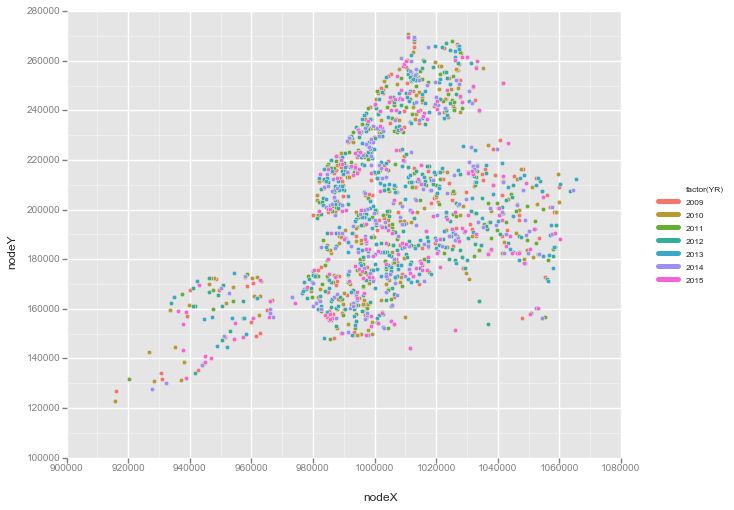
Trends
What’s interesting here is that we can look at this data to see if Vision Zero a project aimed to increase traffic safety, has made a difference. Now this is a bit hard to analyze without other data- for example, if we look at the total number of bike fatalities after 2013, there was actually a spike. But is this because the total number of bikers increased? We would need number of bike fatalities as a proportion of total bikers. The same goes for pedestrian and motor vehicle data.
Next on the agenda: trends over time/time series analysis…